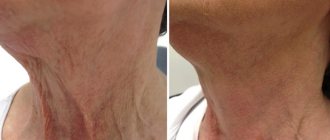- Is this a common occurrence?
- Cleft lip and other pathologies
- Problems for babies with cleft lip
- Defect formation time
- Causes of vice
- Classification
- Treatment of cleft lip
- What does preparation for surgery include?
- Cleft lip removal surgery
- Rehabilitation period
- Cleft lip after surgery
- Contraindications
- Reviews
- Video
Cleft lip , or in medical language cheiloschisis , is a malformation of the maxillofacial region of a newborn in the form of a cleft (cleft) of his upper lip.
Cleft lip
This congenital defect is formed due to the fact that during the prenatal period the tissues of the nasal cavity and upper jaw do not fuse together in the fetus.
The defect is not a threat to the child’s life, but it significantly and for the worse changes his appearance and ability to develop the necessary skills associated with the speech apparatus. That is why it is best to remove a cleft lip as soon as possible.
Problems for babies with cleft lip
- Cosmetic defect (external deformity)
- Difficulty speaking
- Inability to smile
- Difficulty eating (sucking and swallowing in infants)
- Problems of speech development
- The need for special dental care products
The defect is formed in the womb.
With deep clefts, the newborn can be fed through a nasal tube. Subsequently, due to deformation of the teeth and bite, the processes of chewing food are disrupted.
Incorrect development of the dentition leads to the missing of some teeth or, conversely, to the formation of additional ones, their growth at the wrong angle, and a tendency to caries. This, in turn, will require the intervention of an orthodontist to correct the bite, which is sometimes accompanied by transplantation of excess teeth or implantation of missing ones.
Due to a disruption in the sound formation process, children with a cleft lip experience a disorder of speech function (rhinolalia). As a result, the speech of children with such a defect is unclear, it has a pronounced new sound (the so-called “nasality”), and it is difficult for them to pronounce consonants.
The defect can be detected on ultrasound
Features of the operation
In the first month of life, a consultation with a surgeon is necessary. The specialist will determine the nature and extent of the violations, establish the optimal timing of surgical intervention, and tell parents about the action plan and the number of steps required to completely eliminate the problem.
If the child’s condition allows surgery, then correction of physiological disorders caused by a cleft lip is performed in the first month of life. If the baby is underweight, has neurological disorders, intrauterine growth retardation and other health problems, surgical treatment is postponed to a later date. In order for the outcome to be successful, the small patient must be completely healthy, not suffer from rickets, malnutrition, or anemia.
The surgical tactics are determined individually depending on the degree and location of the disorders. The number of stages and their timing are also individual. If there are deformities of the facial skeleton, their complete elimination is possible only after bone growth has completed.
Causes of vice
Cleft lip is formed at the gene level due to a mutation in the TBX22 gene. But this mutation can be provoked by:
- toxicosis;
- stress;
- antibiotic abuse;
- exposure to radiation;
- viral infections (toxoplasmosis, herpes, cytomegalovirus, rubella);
- taking drugs, drinking alcohol and smoking by the expectant mother;
- late birth (when the woman giving birth is over 40 years old);
- chronic diseases in the mother.
Do not smoke!
These factors pose the main danger during the first two months of pregnancy.
Approximate scale of the influence of unfavorable factors on the development of cleft lip:
- 23% – chemical;
- 9% – mental;
- 6% – mechanical injuries;
- 5% – biological;
- 2% – physical, etc.
Causes of pathology
There are many prerequisites for the formation of a pathology called cleft lip; the causes of the pathology are teratogenic in nature and are divided into physical, chemical and biological. Improper pregnancy, accompanied by infectious diseases, folic acid deficiency, severe toxicosis in the early stages of gestation, is one of the main provoking factors. The use of alcohol, tobacco, drugs, and medications during pregnancy increases the likelihood of pathological development of the fetus. This usually happens when a woman is unaware that she is pregnant.
Falls and abdominal injuries, abortions, tumors in the uterus, obesity, mental disorders, and maternal age also have an impact on the abnormal development of the embryo. One of the reasons provoking the appearance of an anomaly is a hereditary factor. If the pathology was observed in blood relatives, then the likelihood of a defect occurring in the child increases by only 7%. In addition, the appearance of pathology is influenced by poor ecology and radiation.
Classification
Congenital cleft lip occurs:
1) one-sided:
- complete, in which there is a complete splitting of the upper lip from the nostril to the red border of the lips;
- incomplete, when part of the lip tissue in the upper part is preserved;
- hidden, characterized by splitting of the lip muscles while maintaining the skin and mucous membrane;
2) double-sided:
- symmetrical, when the cleft on both sides is complete or incomplete;
- asymmetrical, when on one side the cleft is complete, and on the other - incomplete or hidden.
The most common is unilateral cleft of the upper lip to the left of its midline, rarely - bilateral, as well as the lower lip.
In the case of a bilateral cleft, the premaxillary process of the maxilla protrudes forward.
Cleft lip, surgery and types of surgical assistance to eliminate the defect
The choice of surgical intervention technique depends on the classification of the defect. A cleft lip can be unilateral or bilateral, symmetrical or asymmetrical.
There are the following types of cleft lip surgeries:
- Cheiloplasty - a method that allows you to correct the lip. Used for minor and incomplete defects;
- rhinocheiloplasty - helps to correct defects not only of the lip, but also of the nose, as well as muscles. The method is used to restore full attractiveness to the face and allows you to restore all functions of the nose and mouth;
- rhinocheilognatoplasty – allows you to correct deformations of bone tissue, cartilage, mucous membranes, jaw, nose, lip.
Treatment of cleft lip
The treatment of the defect is plastic surgery. There are three types of operations depending on their complexity and invasiveness:
- reconstructive cheiloplasty. It is used in the presence of only a cleft lip in order to restore its natural structure;
- rhinocheiloplasty. This operation affects a large number of organs, for example, cartilage and muscles;
- Rhinocheilognatoplasty. This is an even more complex surgical procedure that affects the formation of the muscular frame of the child’s jaw.
The operation itself is complex and rarely leads to a 100% result the first time. Usually this involves several procedures. However, with successful plastic surgery, complications are a rare occurrence.
Know that today the diagnosis of “cleft lip” is not a death sentence, but only a qualified specialist can treat this defect!
Treatment
A cleft lip requires the mandatory help of a surgeon. The timing and type of surgery depends on the type of cleft lip and the health of the child. Diagnosis is carried out by ultrasound, which shows pathological processes from the 4th month of gestation. But ultrasound readings are not a reason for making a diagnosis. The final diagnosis is confirmed after examining the born child by a neonatologist or pediatrician.
Cheiloplasty is prescribed at the age of 3 to 6 months. Earlier treatment is only possible if the cleft lip is deep and long, which interferes with the feeding procedure. Early surgery improves the formation of facial tissues and reduces the psychological discomfort of parents. At the same time, there is a high risk of blood loss and complications due to the weakness of the systems of the unformed body. The small size of the lips also complicates the surgeon's work.
It is possible to operate at a later date, after the child reaches the age of 1–2 years. A more complex variant of the pathology, cleft lip with cleft palate, will require a number of surgical interventions.
Basic types of operation
After diagnosing the defect, the child is examined by a plastic surgeon, who selects the required type of operation:
- Reconstructive cheiloplasty . It is used in the absence of disturbances in the structure of bone and cartilage tissues. It is performed on the soft tissues of the lip.
- Rhinocheiloplasty . Correction of soft tissues, nasal cartilage, and orbicularis oris muscles is carried out. At the end of the operation, a gauze tampon is inserted into the mouth to protect the stitches from mucus and food particles. After this, a plastic tube is placed in the nose for about 3 months to maintain the cartilage in the desired position.
- Rhinocheilognatoplasty . Defects of the alveolar process of the upper jaw, severe deformation of the nose, and the position of the orbicularis oris muscle are corrected. Various tampons, spacers, and tubes are used to fix the correct position of cartilage and bone structures.
- Osteotomy . The asymmetry of the nasal cavity that appeared after surgery is corrected. Conducted at 16–17 years of age.
Complex cases of pathology require longer treatment, consisting of several stages:
- the first operation is performed at 4–6 months;
- second operation – after 2.5 – 3 months;
- surgery to bring the wings of the nose together and lengthen the skin of the septum;
- After the formation of the facial bones (at 16–18 years), the final correction of the nose is performed.
After surgery to correct a deep defect, the child must wear a special device. This is a bandage made from strips of adhesive tape attached to a wire. It goes through the upper lip and is fixed in the area of the head and cheeks. The design protects the seams from stretching and maintains their integrity. For about 3 weeks, the child’s arms are fixed with a splint so that he cannot damage the stitches. The scar remaining after the operation is barely noticeable. Wound healing occurs relatively quickly.
Sutures are removed on the fifth day, but self-absorbable sutures are more often used. The baby is fed using a transverse nipple. After eating, it is necessary to treat the suture lines with hydrogen peroxide and antibiotic ointment. The cleft lip after surgery should be protected from infection. Regular monitoring by several specialists is necessary: dentist, orthodontist, otolaryngologist, speech therapist, psychologist, specialized therapists. Parents should pay attention to the development of language, speech, and hearing in the child.
Cleft lip removal surgery
The average age of a child at surgery is from 3 to 6 months. Depending on the severity of the defect, an appropriate type of reconstruction of the upper lip is performed, and, if necessary, restoration of the nasal cartilage. In addition, due to the effect on the muscular system of the mouth, its functionality increases.
After the surgeon has completed the reduction and sutured the split tissue of the lip and nose, he places a gauze pad in the baby's nasal passage to protect the fresh stitches from food and mucus and to prevent narrowing of the child's nasal passage.
If the operation is not performed in the first six months of the baby’s life, then when the child is older (for example, at 3 years old), after the operation he will already need serious treatment from a speech therapist and procedures to eliminate scars.
At what age should you have cleft lip surgery?
This is a question that worries many parents. Surgeons recommend turning to them for help when the child is 4-6 months old. Minor damage can be removed very quickly by the surgeon, so parents should not panic or worry. If your baby has a cleft lip, surgery will quickly and permanently eliminate the congenital defect.
Reviews
Maria: I'm 30 years old. I had 3 surgeries, the first at 4 months, the next at 4 years and the last at 13 years. Now there is a slight crooked nose and a scar on the lip, but it is not noticeable. At the moment I don’t feel any complexes about it. Advice to parents: there is no need to hide the truth from your child. My parents lied to me, saying that I just had a bad fall as a child. As a result, I didn’t learn the truth from them, at the age of 12, and not in the best way. It was very unpleasant.
Alesya: Now my daughter is 11 years old. There is still cosmetic surgery ahead and some minor nose trimming once the skull and nose have fully grown. There is a scar, but not critical. Nothing negative so far. Perhaps she will be worried during her difficult adolescence, but I will try to smooth out this problem.
Tamara: When I was pregnant with my youngest daughter, no one told me anything. Even after giving birth, none of the doctors noticed anything! My daughter had a very small cleft palate, only near the uvula. It was just when she yawned that I noticed something was wrong. I went to the doctor and he confirmed that the palate had not partially fused. We had surgery when we were one year old, and now everything is fine. There is no more defect. Three months after the operation, my daughter began to speak and is developing well. I almost forgot that there was some kind of problem.
Elimination methods
Treatment of cleft lip is carried out only by surgery.
The recommended age of a child for surgery is 3-6 months; if the child was born at term and has no other developmental defects, then the operation can be performed within the first month after birth. There are several plastic surgery techniques used to eliminate this disorder: cheiloplasty, rhinocheiloplasty, rhinocheilognatoplasty.
- Cheiloplasty
is usually performed as the first, preliminary, stage of eliminating a cleft lip or in the case of a mild form of the defect. During this procedure, the surgeon compares the affected tissues and then connects them. - Rhinocheiloplasty
involves eliminating not only soft tissue pathology, but also correcting the muscles of the mouth and/or cartilage of the nose. - Rhinocheilognatoplasty
is used for severe forms of pathology: deformation or underdevelopment of the upper jaw. This technique is indicated for children with continuous clefts of the lip and palate.
Prevention
To minimize the risk of having a child with a cleft lip and cleft palate, expectant parents should:
- to refuse from bad habits;
- plan your pregnancy in advance;
- get tested for STIs and TORCH;
- consult a geneticist if one of your relatives has this pathology;
- avoid unnecessary use of medications;
- eliminate stress;
- plan pregnancy at a young age.
This article is posted for educational purposes only and does not constitute scientific material or professional medical advice.
How long can it be determined
Currently, the diagnosis of cleft lip and cleft palate is established in the womb, based on the results of an ultrasound examination. The formation of the jaws and facial organs occurs in the first 8 weeks of pregnancy. It is at this time that signs of a cleft lip and cleft palate begin to appear.
Already at 14-16 weeks, pathology can be detected, but the doctor will fully assess the shape and volume of the lesion only after the birth of the child.
It is important to know that the fetus is mobile, it can cover its face with its hands or turn its back to the sensor, so the ultrasound specialist may not notice the pathological process.. Cleft lip on ultrasound photo
Cleft lip on ultrasound photo
Cleft palate on ultrasound at 20 weeks photo
Often parents learn about anomalies of the maxillofacial region in late pregnancy or after birth. If the ultrasound shows that the child has a cleft lip and palate, parents are advised to seek advice from an oral and maxillofacial surgeon.
This way you can prepare for childbirth and get answers to most of your questions. All necessary specialists will be on site, since during childbirth there may be aspiration of amniotic fluid in the newborn. The surgeon must examine the baby before discharge from the hospital to identify side problems.
1. Cleft lip before and after
2. Cleft lip before and after
Cleft palate before and after
Consequences that pathology leads to
The disease not only looks unaesthetic, but also significantly reduces the child’s quality of life. Until surgery is performed to correct the defect, children and parents may encounter the following difficulties:
- Violation of the processes of sucking and swallowing. The newborn does not gain weight well and is developmentally delayed. For complex clefts, feeding is carried out using a special nasal tube. Also, special spoons are used for feeding, which are placed on bottles.
- Speech dysfunctions. Difficulty arises in the pronunciation of consonant sounds, nasality and vagueness are noticeable.
- Malocclusion. Leads to poor-quality chewing of food and problems with the gastrointestinal tract. There may be additional teeth with an incorrect growth angle or, conversely, a lack of dental units.
- Manifestations of otitis, sinusitis and other infectious diseases of the ears and facial sinuses. Characteristic of cleft palate. This occurs due to the reflux of inhaled air and fluids from the nasal cavity into the middle ear area.
- Deterioration of the sense of smell, disorder of auditory function, abnormalities in the development of the skull bones.
Manifestations of a cleft palate
Difficulties in children with cleft palate begin from the moment of birth, because during childbirth, aspiration of amniotic fluid into the respiratory tract is possible. The breathing of a newborn with a cleft palate is difficult, sucking is impossible, which is why the child lags behind in weight and development. Feeding the baby before surgery is carried out using special spoons that fit onto bottles.
The presence of a cleft palate disrupts the normal functioning of the upper respiratory and digestive tracts, the development of speech and hearing, and can also cause a decrease in the child’s self-esteem. In children with a cleft palate, speech is changed due to a disruption in the process of correct formation of sounds. Speech disorders are expressed in open rhinolalia, causing FFF or ONR.
A defect in the palate leads to the free passage of inhaled air through the nose, as well as the entry of food and liquid into the nose. Fluid through the cleft palate can enter the Eustachian tubes and sinuses, which contributes to the development of otitis media and sinusitis in such patients. With a cleft palate, there is a deformation of the bite and teeth that interfere with the process of chewing food.
General information
Cleft palate (palatoschisis) is a congenital malformation of the maxillofacial region, which is a splitting of the soft and hard palate, leading to disruption of the processes of breathing, nutrition, and sound production. The defect is formed as a result of delayed fusion of the processes of the upper jaw with the unpaired bone of the facial part of the skull - the vomer. 0.1% of newborns in the world are born with a cleft palate.
With a cleft palate, cleft palate can be: complete - with a cleft in the hard and soft palate and incomplete - with a hole in the palate. The presence of a cleft palate is often combined with a bifurcation of the uvula, a process of the posterior part of the soft palate as a result of a disruption in the connection of the medial, lateral palatine processes and the nasal septum. Cleft palate is one of the most common birth defects.
The formation of cleft palate is genetically determined: when working with data from deciphering the human genome, British scientists in 1991 discovered the gene responsible for the development of cleft palate - this is the modified TBX22 gene, located on the X chromosome. Factors leading to changes at the gene level and contributing to the formation of a palatal defect are teratogenic effects on the fetus. Today, the relationship between the formation of a cleft lip and cleft palate in a child and the expectant mother’s addiction to alcohol, smoking and drugs has been clearly traced.
The risk of developing a defective upper jaw increases with maternal obesity and a lack of folic acid in her diet. Environmental problems in the area where the pregnant woman lives, toxicosis and acute infections she has suffered, and mental or mechanical injuries also contribute to the development of cleft palate. In the first three months of development, the fetus is most vulnerable and susceptible to the effects of various types of damaging factors; it is during this period that the formation of the maxillofacial organs occurs.
Cleft palate and cleft lip: similarities and differences
Cleft palate and cleft lip are birth defects that have similar characteristics, although they are different from each other.
| Cleft lip | |
| A cleft forms in the palate and can affect both the hard and soft. | It is a vertical fissure that is located in the upper lip. May spread to the bones of the upper jaw and nose. |
| It is formed in the first 2 months of intrauterine development of the fetus. | Most often it forms at the 8th week of pregnancy, when active formation of organs and systems occurs. |
| It may be a single pathology or present in conjunction with a cleft lip. | Most often it is diagnosed as an independent disease, but it can “go” along with the cleft palate. |
| Diagnosed by ultrasound examination of a pregnant woman in the last months. | It is detected by ultrasound already at 20-23 weeks of pregnancy; when working with modern equipment, accurate diagnosis occurs at 16 weeks of pregnancy. |
| It does not lead to mental retardation, the child develops physically within normal limits, but if left untreated, speech suffers. | The mental, psychological and physical development of the baby proceeds within normal limits. Speech, without surgery, is distorted, which leads to learning delays. |










